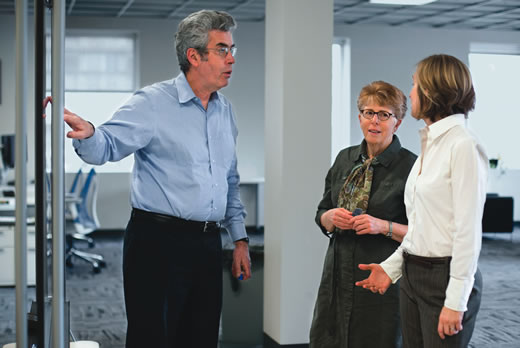There's no getting around it. Even with the best of care, a stay in the hospital is no picnic. Patients are there to recover from severe trauma or major surgery, while others are battling acute and chronic illnesses. During their stay, patients endure the lion's share of discomfort and disruptions — bright lights, beeping monitors, bedpans, sponge baths, diagnostic tests, blood draws, IVs, catheters, cannulas, and yards of plastic tubing—day and night. When patients are discharged and go home, one of the things they crave most is several hours of uninterrupted sleep.
But is it possible to help patients sleep better while they are in the hospital? The mock hospital room in the SimTigrate Design Lab at the Georgia Institute of Technology may hold the answer. Though the room is sparsely furnished with only a hospital bed and a lighting control, it serves as an important testing ground for two studies designed to help inpatients rest more comfortably and heal more quickly.
The Nell Hodgson Woodruff School of Nursing is a collaborator on both projects, initiated when two manufacturers — Philips Lighting and Hill-Rom — asked Georgia Tech architecture professor Craig Zimring PhD and associate lab director Jennifer DuBose MS to analyze their lighting and hospital bed products. The companies came to the right source. A few years ago, Zimring established the SimTigrate Design Lab as an incubator for health care innovation. The lab brings Georgia Tech faculty and students together from multiple disciplines — architecture, industrial design, mechanical engineering, health systems engineering, environmental psychology, and computer sciences — to analyze, predict, and optimize health outcomes. Emory nursing and medical faculty also play a role.
Shortly after joining Emory in 2010, clinical nursing professor Susan Shapiro PhD RN FAAN met with David Cowan MSHS, program director of the Health Systems Institute, an initiative of Georgia Tech and Emory, to brainstorm and share ideas. The synergy flowed from there.
"Solving problems in silos is not effective," says Cowan, who brought Shapiro and Zimring together as collaborators. "We can achieve the best outcomes by solving problems together."
Shapiro now serves as an adjunct research faculty member in the College of Architecture at Georgia Tech. "That's been a very fruitful connection," she says. Shapiro provides the clinical perspective that researchers in Georgia Tech's SimTigrate Design Lab seek to design, engineer, and build the facilities, products, systems, and technologies that improve health care delivery and outcomes. She also plays matchmaker, connecting researchers and health experts on SimTigrate Lab projects.
For the lighting study, Shapiro and DuBose assembled a group of Emory Healthcare nurses, physical and respiratory therapists, dieticians, and physicians to advise Georgia Tech experts on factors and measures related to patient sleep and how sleep may be related to patient outcomes. Their input will help in analyzing the benefits of Philips' HealWell system, which provides general lighting and mimics natural light by adjusting automatically from low light to bright light and back to mirror circadian rhythm. Previous studies have shown that natural light improves sleep and reduces pain and length of stay for patients and eases eyestrain and increases the cognitive performance of nurses.
Shapiro also invited EUHM nurses to assist with the hospital bed study. The nurses worked with DuBose's team to develop a detailed model tracing the factors and events in hospital care that can disrupt sleep. Among the disrupters: touch, pain, light, noise, temperature, and psychology related to discomfort and anxiety. Ultimately, the analysis will help inform Hill-Rom's efforts to engineer hospital beds that increase sleep quality and duration for inpatients.
"Hill-Rom provides the vast majority of beds in hospitals. Until now, the company regarded the beds as a medical device and had not thought much about sleep," Zimring explains. "We're looking at how to bundle the care process with technology so that patients can get more hours of quality sleep. One idea is to install a bed sensor. If you can sense that someone is asleep, you know not to disturb that patient."
The hospital and lighting studies are still under way, and Shapiro is helping ensure the results will help enhance clinical care.
"These studies have one thing in common—improving the quality and quantity of sleep for inpatients," she says. "With better sleep, patients can approach the next day more rested and with more energy to participate in physical therapy, occupational therapy, and other activities they need to return them to good health."
"One of the reasons I love working with Craig and Jennifer's team is this idea of the built environment in which care is given," she adds. "Within the constraints that we have, how can we alter the built environment to improve patient experiences and outcomes? That's the goal of this team."

